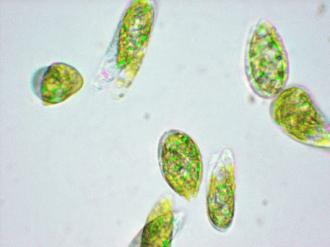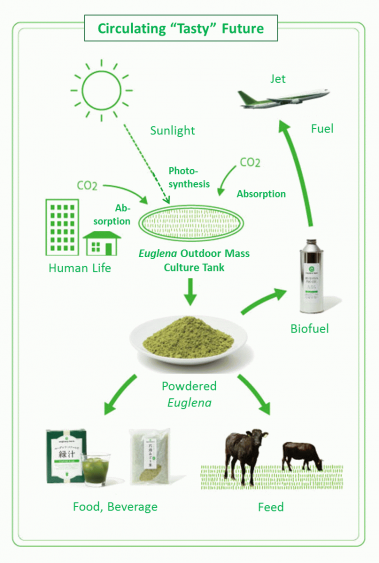Euglena, sujiri mojiri
- Kengo Suzuki
- Director, General Manager of R&D Department, euglena Co., Ltd.
I have been a “science boy” for as long as I can remember. Due probably to the influence of my father, who was a veterinarian, I was intensely interested in all living things around me and had a strong desire to understand the matters. My curiosity was manifested in an endless flow of questions about the causes of natural phenomena that my parents had to field. My favorite book was a science encyclopedia that explained various types of phenomena occurring in our immediate environment in a manner easy for an elementary school student to understand.
One day, my father presented me with a microscope, and I realized that, in addition to the visible world, there was another world that could be seen only through the microscope lenses. For instance, a microscope could reveal an entirely different world even in a drop of water. A strip of thin onion skin is, in fact, an orderly and well-organized structure of cells when examined under microscope. I felt great excitement when this amazing micro-world was unveiled to me by the power of the microscope.
The microscope, which deepened my curiosity about the realm invisible to the naked eye, was invented in the late 16th century. Its invention enabled Dutch scientist Antonie van Leeuwenhoek, commonly known as "the Father of Microbiology," to discover, in the 17th century, a microorganism that was born more than 500 million years ago, in the primitive age after the birth of the earth. The name of this microorganism is “Euglena,” a combination of the Latin words eu (beautiful) and glena (eye).
Some taxonomists classify Euglena as an alga, together with wakame seaweed and kelp, but in fact it is a “hybrid” organism that possesses features of both plants and animals. Like plants, Euglena has chloroplasts within the body of the cell, which enable it to store nutrients produced by the means of photosynthesis. At the same time, it can move around independently by contracting the body of the cell, like animals do.
Euglena is an extremely tiny microorganism with a length of only 0.05mm, but thanks to its extraordinary features, it holds an enormous potential to solve some of the most serious problems faced by our planet today: those of food supply and global warming. At the same time, Euglena could possibly contribute to the maintenance of biodiversity.
Why is Euglena capable of solving the food supply issue? I will explain the reasons here.
As an organism that has features of both plants and animals, Euglena contains, in a natural form, a total of 59 types of nutrients, which, in addition to vitamins and minerals typical for vegetables, also include unsaturated fatty acids such as DHA and EPA normally found in fish. Among these nutrients, paramylon, a β-1,3-glucan, merits special interest. It is a specific substance that only Euglena can produce. The surface of the paramylon macromolecule contains numerous micro-holes, through which it absorbs unwanted substances, such as excessive fats and cholesterol, and discharges them in the state in which they were absorbed. It can also inhibit the absorption of purine bodies. These and other versatile applications of paramylon thus give rise to expectations for its beneficial effect on human health. Another major biological feature of Euglena is that it has a cell membrane instead of the cell wall found in most plants. This feature enables intake of nutrients of plant origin, which are otherwise difficult to absorb by the human body, with a very high coefficient of digestibility.
In order to utilize Euglena as a high-protein food with an outstanding nutritious value that contains almost all nutrients necessary to sustain human life, it is necessary to produce it on a mass scale and develop it as a food resource. If we could achieve this, we would solve the global food supply issue.
Euglena also has the potential to contribute in a great measure to the solution of the global warming problem. Euglena is capable of absorbing the ever-increasing carbon dioxide emissions in the atmosphere thanks to its outstanding photosynthesis efficiency that reportedly exceeds by ten times that of the tropical rainforests.
Although the current climate changes triggered by the global warming are not as drastic as those during the ancient times when a giant asteroid collided with the earth, wiping out the dinosaurs and changing the planet’s biodiversity, they nevertheless create conditions that threaten the survival of many organisms and eventually have become one of the reasons for loss of biodiversity.
Based on this presumption, it could be claimed that the outstanding carbon dioxide reduction potential of Euglena will contribute to curbing global warming and maintaining biodiversity.
Currently, there are reported cases of more than 100 different species of Euglena around the world. Access to genetic resources and the fair and equitable sharing of benefits arising from their utilization is one of the objectives of the Convention on Biological Diversity (CBD), and since Euglena exists in various countries around the world, if we consider the prospects for its industrial utilization in the future, there is a possibility that, as a major resource for new industries, Euglena could bring fair and equitable sharing of benefits for each country.
Even if we consider Euglena simply as a genetic resource, outside the context of the CBD, we will see that it is an extremely beneficial organism. By extracting the genetic information of Euglena and combining it with that of different organisms, it may be possible to utilize its valuable properties in a broad range of industries. For instance, a transfer of genetic information from Euglena to plants could benefit the production of fibers, improve plants’ functionality as animal feed, boost the effectiveness of soil activators, or even enable plants to produce oil that only Euglena contains.
euglena Co., Ltd. is committed to developing business activities that utilize the beneficial properties of Euglena in five fields that we call the “5 Fs of Biomass”: food, fiber, feed, fertilizer, and fuel. Through such activities, our company will aim for the realization of a sustainable carbon cycle society using Euglena.
In the traditional mass consumption society, people burn fuels (oil or coal) and use the energy to make various products necessary for their lives, such as chemical fibers, for instance. Euglena-based products could replace almost the entire array of products derived from such underground resources. In other words, it is possible to aim for the creation of carbon cycle society based on Euglena, a ground resource, in all aspects of clothing, food, and accommodation, without having to newly extract underground fossil fuels.
Fibers, the main source of materials for clothing, could be produced from Euglena. As for food, as mentioned above, Euglena is a high-protein food source with excellent nutritional properties. It can be utilized effectively in the production of feed for livestock and farmed fish. As for the accommodation aspect of Euglena utilization, the energy necessary for maintaining a house and day-to-day life could be supplied from the oil contained in Euglena. Furthermore, we are currently advancing research to promote improvement of the durability of housing building materials through the combination of Euglena with various resources.
If we convert from a society that burns fuels extracted from the ground, such as coal and oil, in order to sustain life into a society that relies on the circulation of aboveground resources to meet all its needs, the concentration of carbon dioxide emissions in the atmosphere will not increase overall. We believe that a world that utilizes the diverse potential stored in Euglena will come closer to our ideal for a sustainable society based on effective circulation of various resources on a global scale.
Further ahead in the future, we will aim to build an effective cycle based on Euglena utilization in space by cultivating Euglena at space stations and having it convert the carbon dioxide emitted by humans into oxygen and produce food.
Despite the enormous potential of Euglena to save the world, its position at the very bottom of the food chain has made outdoor mass culture very difficult for many years.
Cultivation of Euglena in flasks, etc., under laboratory conditions, in which air, temperature, and light can be controlled, is not so difficult. Growing of Euglena in tiny flasks only, however, is not a realistic approach if our goal is to realize mass culture for the purpose of its utilization as food, etc. It is necessary to grow Euglena in wide spaces exposed to fresh air, rather than in restricted environments such as laboratories. In the atmosphere, however, there are various microorganisms that will immediately prey on Euglena.
We solved this unavoidable problem and succeeded in realizing outdoor mass culture by approaching the task from a different angle and creating an environment in which only Euglena could survive. Normally, scientists conduct experiments that anyone could replicate, but we took the exactly opposite approach, which is rarely applied in scientific research. Under this approach, we conducted a series of studies and experiments, focusing our efforts on creating a living environment that is hospitable to Euglena, but hostile to any other organisms. We took advantage of Euglena’s ability to remain unaltered by the addition of acids, and, through continuous efforts to acidulate the culture solution, managed to create an environment in which only Euglena could grow. Finally, in 2005, our company successfully realized the world’s first outdoor mass culture of Euglena.
Incidentally, the title of this article includes the term “sujiri mojiri.” This is a Japanese term that describes a specific undulating motion typical of Euglena (Euglenoid movement or Euglena movement). Euglena has the habit of moving in the direction where it can find more light through the undulating, contractile movements of its cell.
I find this undulating motion extremely endearing. Observing it is a very soothing experience for me.
We, humans, are multicellular organisms capable of moving independently by having the brain send signals that in turn set in motion our muscles and bones. In contrast, as a single-cell organism, Euglena can only undulate and contract its entire body as it tries to inch closer to a source of light. To me, the sight of this peculiar movement is truly mystifying and I could never get tired of watching it. I am keenly aware that this is the movement of “life.”
Even today, when I go on a business trip, I always make sure to have falcon tubes tucked in my bag, so that I can take samples of water I find in somewhat unusual environments, such as places with carbonated water, gutters, and areas where sea water and fresh water mix. Later, I examine these samples under microscope, thinking that I might come across a new Euglena species. When I see the energetic undulating motion of the Euglena cells, the fatigue of the trip disappears. I believe that observing Euglena is my life’s work.
Euglena employs an undulating motion to advance in the direction of light. Even though it is a very tiny organism visible only under microscope, Euglena possesses enormous potential to lead our planet toward a future filled with abundant light.
Profile of Kengo Suzuki
Mr. Kengo Suzuki is a graduate of the Faculty of Agriculture at the University of Tokyo and has a BSc in system engineering. Mr. Suzuki jointly established euglena Co., Ltd. with Mr. Mitsuru Izumo (President, euglena Co., Ltd.) in August 2005 and took up his position as Director, General Manager of the R&D Department. In December 2005, he succeeded in the world’s first outdoor mass culture of Euglena for food use. In 2006, he earned his master’s degree from the Graduate School of Agricultural and Life Sciences, Faculty of Agriculture, the University of Tokyo. Since the establishment of the company, he has been engaged in the production and development of Euglena-derived biofuels.
euglena Co., Ltd was awarded the Grand Prix of the Tokyo Venture Technology Award in 2010. He is a co-author of Bisaisorui no Tairyoseisan, Jigyoka ni muketa Baio-gijyutsu (in Japanese, “Culture Technology toward the Mass Production and Commercialization of Microalgae”) (Johokiko Co., Ltd.).













